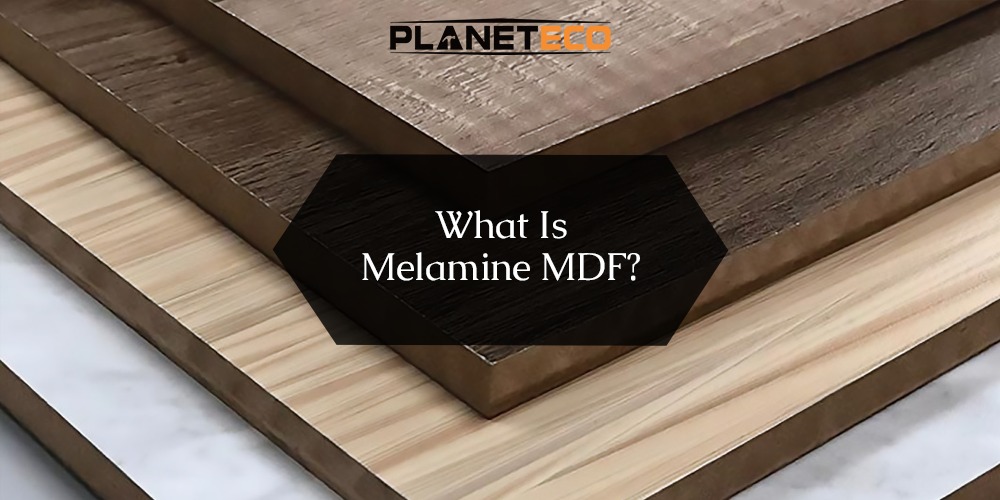Melamine MDF might sound like a tough piece, but it’s actually one of the most suitable materials used in homes and businesses today. Whether you’re furnishing a new apartment or remodelling your office, chances are you’ve come across this material more than once, mainly if you’re exploring bearable options like those offered by Planeteco.
Understanding MDF (Medium Density Fiberboard)
Before diving into melamine, let’s start with MDF. Medium Density Fiberboard is an engineered wood product made from wood fibers, wax, and resin sealed into flat panels under high pressure and heat. It’s known for its smooth surface, affordability, and versatility.
What Is Melamine?
Melamine is an artificial resin often used as a laminate. When it’s combined with paper and heat-pressed onto materials like MDF, it forms a tough, scratch-resistant surface. Think of it as a protective, decorative skin for otherwise plain boards.
Composition and Manufacturing
How Melamine MDF Is Made
The process begins with the production of MDF panels. Once ready, these panels are laminated with melamine-impregnated paper using high heat and pressure. The result is a durable, ready-to-use board. At Planeteco, emphasis is placed on eco-conscious processes that limit formaldehyde emissions and utilize responsibly sourced materials.
Layers and Coating Process
Melamine MDF consists of three main layers:
- Core MDF board
- Decorative melamine-impregnated paper
- Protective resin layer
This multi-layer design gives the board its characteristic strength and style.
Types of Melamine MDF
- Decorative Melamine MDF
These are often used in furniture and interiors where design matters. They come in a variety of colors, patterns, and textures, from woodgrain to solid shades. - Industrial Grade Melamine MDF
Used in heavy-duty applications, these boards are thicker and offer higher resistance to wear, heat, and moisture.
Key Features of Melamine MDF
- Durability and Strength
Melamine MDF is known for its ability to withstand everyday wear and tear. Whether it’s scratches, dents, or heat, it holds up impressively well
- Is Melamine MDF Waterproof?
This is a common question and the answer is no, melamine MDF is not fully waterproof. The melamine surface layer provides a degree of moisture resistance, but the core MDF is still susceptible to water damage if exposed for extended periods.
- Water and Heat Resistance
While not completely waterproof, it does offer decent resistance to spills and heat, making it ideal for kitchens and bathrooms. - Cost-Effectiveness
Compared to solid wood, melamine MDF is far more affordable without sacrificing quality or appearance. - Aesthetic Appeal
With hundreds of design choices, it’s easy to match melamine MDF with any decor style—modern, classic, or industrial.
Uses and Applications
- Furniture Manufacturing
From wardrobes to TV units, melamine MDF is a go-to material for furniture manufacturers due to its ease of use and beautiful finish. - Kitchen and Bathroom Cabinets
Because of its moisture resistance, it’s perfect for cabinetry that’s exposed to water, steam, and heat. - Wall Paneling and Shelving
Need stylish shelves or a feature wall? Melamine MDF offers functionality and design in one package. - Office and Commercial Use
Desks, partitions, and display units in commercial settings often rely on melamine MDF for durability and aesthetics. Many modern projects choose Planeteco melamine MDF for its sustainable and stylish appeal.
Melamine MDF vs. Other Materials
- Melamine MDF vs. Solid Wood
Solid wood is stronger and more natural-looking but also more expensive and less uniform. Melamine MDF offers a modern alternative at a fraction of the cost. - Melamine MDF vs. Plywood
Plywood is stronger in structural uses, but melamine MDF wins in surface smoothness and design options. - Melamine MDF vs. Particle Board
Melamine MDF is denser, smoother, and more durable than particle board, making it a better long-term investment.
Pros and Cons
Advantages
- Affordable
- Wide range of designs
- Durable and low-maintenance
- Resistant to warping and cracking
Disadvantages
- Not ideal for outdoor use
- Can chip during cutting if not handled properly
- Heavier than other alternatives like plywood
Working with Melamine MDF
Cutting and Drilling Tips
Use a fine-toothed blade and tape along the cut line to avoid chipping. Pre-drilling holes for screws is also recommended.
How to Avoid Chipping
Always use sharp blades and consider applying masking tape where you cut. Cutting slowly also helps reduce chipping.
Maintenance and Cleaning
Daily Cleaning Tips
Just use a soft cloth and mild detergent. Avoid harsh chemicals and abrasive scrubbers.
Long-Term Maintenance
Don’t let water sit for too long. Regular dusting and occasional wiping down will keep it looking fresh.
Eco-Friendliness and Sustainability
Is Melamine MDF Environmentally Friendly?
While not biodegradable, many manufacturers—including Planeteco—now offer low-formaldehyde options, and some use recycled wood fibers.
Recycling and Disposal Tips
Check with local recycling centers. Some accept MDF for reuse or proper disposal.
Buying Guide
Factors to Consider
- Thickness
- Surface texture
- Color and pattern
- Formaldehyde emissions (look for E1 or E0 rating)
Recommended Brands and Prices
Brands like Kronospan, Egger, Planeteco, and Greenpanel are widely respected. Prices vary depending on thickness, finish, and brand.
Conclusion
Melamine MDF is a modern solution for interior projects. It combines the practicality of MDF with the sleek finish of melamine. Whether you’re a DIY enthusiast or a professional, melamine MDF opens up a world of design possibilities without draining your wallet. With sustainable options from Planeteco, you get eco-conscious quality, design, and durability all in one smart choice.

